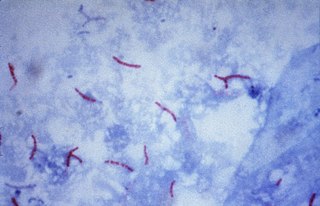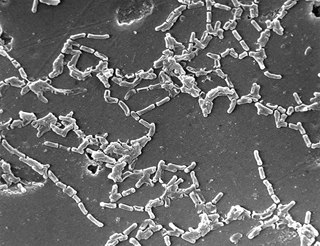Related Research Articles

Mycobacterium tuberculosis is a species of pathogenic bacteria in the family Mycobacteriaceae and the causative agent of tuberculosis. First discovered in 1882 by Robert Koch, M. tuberculosis has an unusual, waxy coating on its cell surface primarily due to the presence of mycolic acid. This coating makes the cells impervious to Gram staining, and as a result, M. tuberculosis can appear either Gram-negative or Gram-positive. Acid-fast stains such as Ziehl-Neelsen, or fluorescent stains such as auramine are used instead to identify M. tuberculosis with a microscope. The physiology of M. tuberculosis is highly aerobic and requires high levels of oxygen. Primarily a pathogen of the mammalian respiratory system, it infects the lungs. The most frequently used diagnostic methods for tuberculosis are the tuberculin skin test, acid-fast stain, culture, and polymerase chain reaction.

Mycobacterium is a genus of Actinobacteria, given its own family, the Mycobacteriaceae. Over 190 species are recognized in this genus. This genus includes pathogens known to cause serious diseases in mammals, including tuberculosis and leprosy in humans. The Greek prefix myco- means "fungus," alluding to the way mycobacteria have been observed to grow in a mold-like fashion on the surface of cultures. It is acid fast and cannot be stained by the Gram stain procedure.
Nontuberculous mycobacteria (NTM), also known as environmental mycobacteria, atypical mycobacteria and mycobacteria other than tuberculosis (MOTT), are mycobacteria which do not cause tuberculosis or leprosy. NTM do cause pulmonary diseases that resemble tuberculosis. Mycobacteriosis is any of these illnesses, usually meant to exclude tuberculosis. They occur in many animals, including humans.
Mycobacterium avium subspecies paratuberculosis (MAP) is an obligate pathogenic bacterium in the genus Mycobacterium. It is often abbreviated M. paratuberculosis or M. avium ssp. paratuberculosis. It is the causative agent of Johne's disease, which affects ruminants such as cattle, and suspected causative agent in human Crohn's disease and rheumatoid arthritis. The type strain is ATCC 19698.

Ziehl-Neelsen staining is a type of acid-fast stain, first introduced by Paul Ehrlich. Ziehl–Neelsen staining is a bacteriological stain used to identify acid-fast organisms, mainly Mycobacteria. It is named for two German doctors who modified the stain: the bacteriologist Franz Ziehl (1859–1926) and the pathologist Friedrich Neelsen (1854–1898).

Mycobacterium abscessus complex (MABSC) is a group of rapidly growing, multidrug-resistant, nontuberculous mycobacteria (NTM) species that are common soil and water contaminants. Although M. abscessus complex most commonly causes chronic lung infection and skin and soft tissue infection (SSTI), the complex can also cause infection in almost all human organs, mostly in patients with suppressed immune systems. Amongst NTM species responsible for disease, infection caused by M. abscessus complex are more difficult to treat due to antimicrobial drug resistance.
Mycobacterium bohemicum is a species of the phylum Actinobacteria, belonging to the genus Mycobacterium.
Mycobacterium bolletii is a bacterial species of the phylum Actinobacteria and the genus Mycobacterium. It was named in honor of Claude Bollet, a famous clinical microbiologist and taxonomist.

Mycobacterium chelonae is a species of the phylum Actinobacteria, belonging to the genus Mycobacterium. Mycobacterium chelonae is a rapidly growing mycobacterium, that is found all throughout the environment including sewage and tap water. It can occasionally cause opportunistic infections of humans.

Mycobacterium fortuitum is a nontuberculous species of the phylum Actinobacteria, belonging to the genus Mycobacterium.
Mycobacterium gordonae is a species of Mycobacterium named for Ruth E. Gordon. It is a species of the phylum actinobacteria, belonging to the genus Mycobacterium.
Mycobacterium hassiacum is a rapid-growing thermophilic mycobacterium that was isolated in human urine in 1997 by researchers at the German University of Regensburg. It's a species of the phylum Actinobacteria, belonging to the genus Mycobacterium.
Mycobacterium immunogenum is a species of the phylum Actinobacteria, belonging to the genus Mycobacterium.
Mycobacterium avium complex is a group of mycobacteria comprising Mycobacterium intracellulare and Mycobacterium avium that are commonly grouped because they infect humans together; this group, in turn, is part of the group of nontuberculous mycobacteria. These bacteria cause disease in humans called Mycobacterium avium-intracellulare infection or Mycobacterium avium complex infection. These bacteria are common and are found in fresh and salt water, in household dust and in soil. MAC bacteria usually cause infection in those who are immunocompromised or those with severe lung disease.
Mycobacterium palustre is a slowly growing mycobacterium first isolated from an environmental source in Finland. It is potentially pathogenic, and has been isolated from human and veterinary clinical specimens.
Mycobacterium triplex is a species of Mycobacterium.
Mycobacterium parmense is a species of Mycobacterium.
Mycoobacterium iranicum is a bacterium from the genus Mycobacterium which has been isolated from a patient from Isfahan in Iran. Eight strains have been isolated from patients from various countries.
Bilophila wadsworthia is a gram-negative, obligately anaerobic, catalase-positive, bile-resistant, and asaccharolytic bacillus. This bacterium is about 0.7 μm wide by 1.0–10.0 μm long in colony and the cells are pleomorphic with irregular cell walls. This bacterial species is mostly urease positive; around 75% of the strains are urease positive. Less than 0.01% of the human gut microbiota is this bacterium. B. wadsworthia is linked to various diseases and is not well known due to frequent misidentification of the bacteria. The two unique characteristics of B. wadsworthia are the utilisation of the sulfated amino acid taurine in the production of hydrogen sulfide and the rapid catalase reaction. This bacterium is vulnerable to the antibiotics: imipenem, ceoxitin, and ticarcillin, which are all β-lactam antibiotics.

Mycobacterium ulcerans is a species of bacteria found in various aquatic environments. The bacteria can infect humans and some other animals, causing persistent open wounds called Buruli ulcer. M. ulcerans is closely related to Mycobacterium marinum, from which it evolved around one million years ago.
References
- 1 2 Bang, D.; Herlin, T.; Stegger, M.; Andersen, A.; Torkko, P.; Tortoli, E.; Thomsen, V. (Oct 2008). "Mycobacterium arosiense sp. Nov., a slowly growing, scotochromogenic species causing osteomyelitis in an immunocompromised child". International Journal of Systematic and Evolutionary Microbiology. 58 (Pt 10): 2398–2402. doi: 10.1099/ijs.0.65503-0 . ISSN 1466-5026. PMID 18842863.
- 1 2 Tortoli, E.; Adriani, B.; Baruzzo, S.; Degl'Innocenti, R.; Galanti, I.; Lauria, S.; Mariottini, A.; Pascarella, M. (Jun 2009). "Pulmonary disease due to Mycobacterium arosiense, an easily misidentified pathogenic novel mycobacterium". Journal of Clinical Microbiology. 47 (6): 1947–1949. doi:10.1128/JCM.02449-08. ISSN 0095-1137. PMC 2691113 . PMID 19386835.